The Screenwriter's Toolbox Part III: The Beat Board™
September 30, 2021
In previous articles, we've covered loglines, synopses, treatments and pitches. These are all basically marketing tools used to promote the work, and guiding writers in mastering these tools can help them understand the bigger pictures in scriptwriting and film.
Beat sheets on the other hand, while contributors to the bigger picture as well, are typically unrelated to marketing. There can be many types of beat sheets: For actors, directors, etc. Most of the time though, the beat sheet is used by screenwriters to get across the story points, see the overall story tack, and diagnose issues.
My first exposure to a beat sheet was on a project I was hired to write. At that point, I had written 10-15 scripts, some of which were produced. Yet this project was difficult for who knows what reason. It wasn’t particularly complicated—a genre script—but I couldn’t get it right. The producer I was working with at the time suggested I “beat it out.” I was hoping she meant with a hammer, but she introduced me to beat sheets and it changed my writing life.
WHAT IS A BEAT?
A beat is a story point. Beats connect and move the story forward. They can be tentpoles (big important moments), but mainly they act like the connecting tissue for the script.
Beats also dovetail into scene sequences. This scene plus this scene plus this scene equals the beat. It might take three-to-four smaller scenes to get to a story beat. Showing a character getting into their car, driving on a freeway, arriving at their destination, are not beats. In fact, unless there’s something specific you’re trying to accomplish with those sequences, they're also deletable. But if you did need the journey in the car for some reason; the destination would be the beat. Actually, more to the point, what a character does at that destination is the beat.
We’re going to “beat out” an old favorite movie and see how that all works. But let’s look at a great tool that comes built into Final Draft, first.
BEAT BOARD/STORYMAP
Since the early versions of Final Draft, tools like Beat Board have been available. Beat Board is a handy app embedded inside the script you’re writing. It goes with the script so you can always access it inside the project.
Storymap is another tool that works seamlessly with Beat Board, but won’t be covered in this article. Look for future articles on Final Draft’s toolbox. There’s a lot to be said about these tools and Final Draft has provided a comprehensive set of help videos to understand them better.
Watch this for in-depth Beat Board tutorials, but basically, it’s this simple to look at the "bigger picture" in your work-in-progress:
Split your screen: HOME > SPLIT SCREEN VERTICALLY.
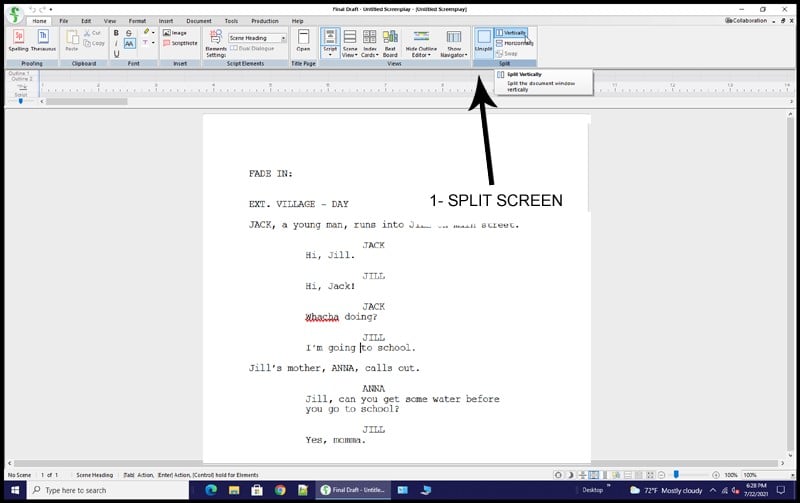
Click on BEAT BOARD: HOME > BEAT BOARD.
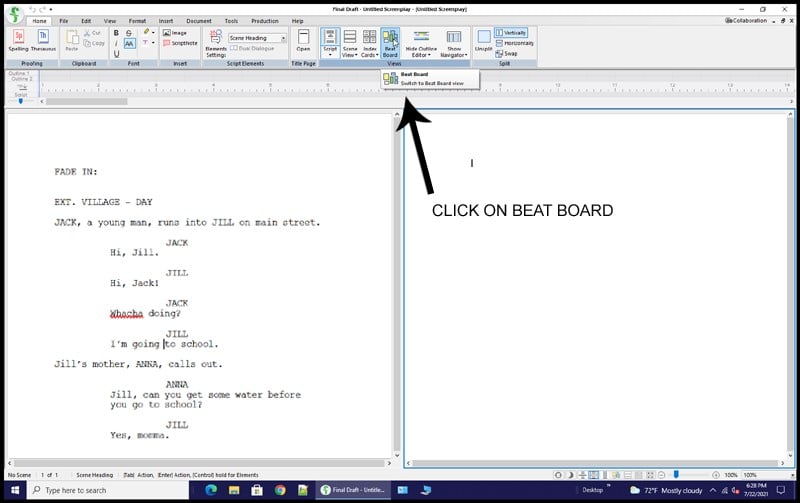
DOUBLE CLICK IN BEAT BOARD TO ADD A BEAT. FILL IN TITLE, INFO.
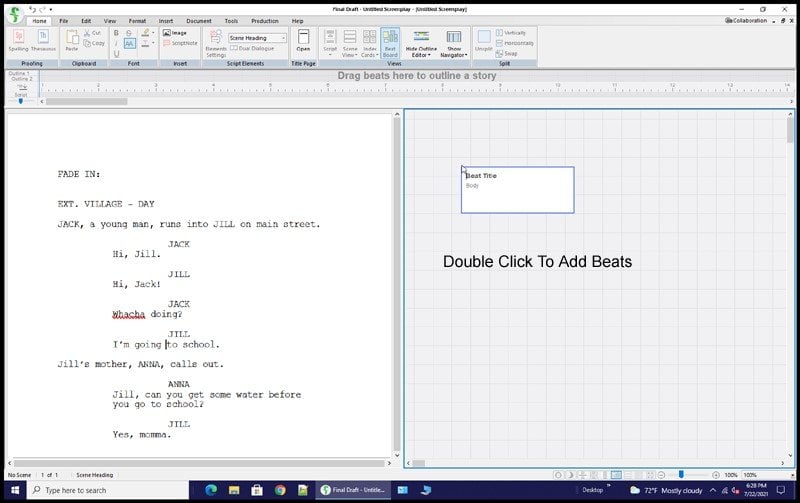
KEEP BUILDING BEATS. INSERT WHERE NECESSARY IN BETWEEN.
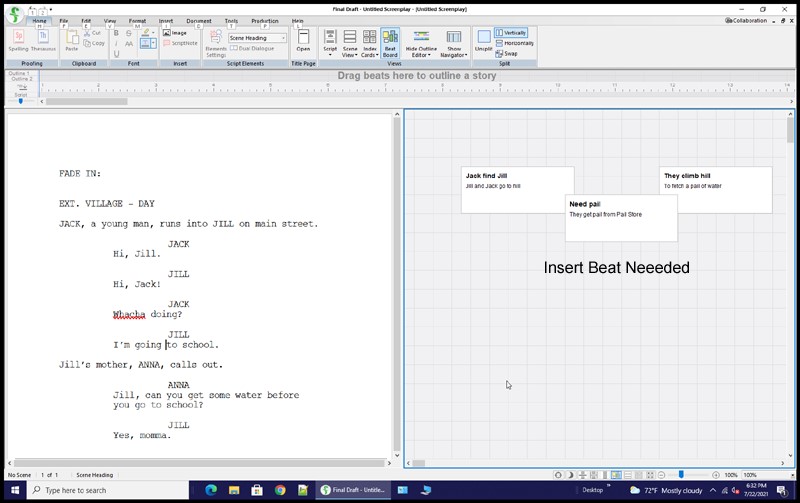
YOU CAN DRAG THE BEATS ALL AROUND THE BEAT BOARD TO CHANGE THE STORY FLOW.
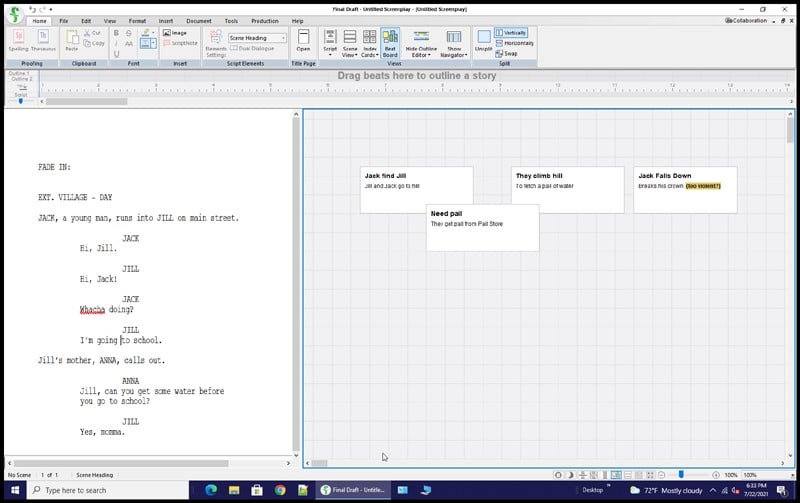
YOU CAN ALSO ADD BEATS DIRECTLY FROM A SCRIPT BY HIGHLIGHTING AND DRAGGING TO BEAT BOARD.
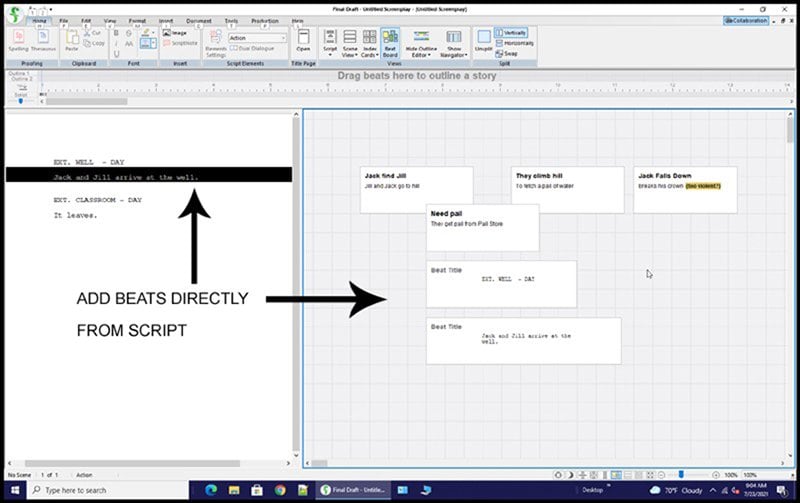
Another great tool is the lasso tool. You can create on the Beat Board, then lasso the beats and send them directly back to the script.
There are a ton of other things you can do in Beat Board in Final Draft like add images, color code beats, etc., so please check out the excellent tutorials at https://www.finaldraft.com/learn/.
WHY DO BEATS WORK?
I think there are two fundamental mechanisms at play for beat sheets.
One, we know how to tell a story. It’s almost a part of our DNA. As we grow we’re told fairy tales, watch cartoons, hear moral tales from cultural sources, etc. By the time we’re of an age to write our own stories, a certain amount of natural ability takes over.
My middle sister who is not a writer is a storyteller par excellence. Actually, everyone in my family is. They can all make a trip to the grocery store sound like an Oscar®-nominated film. They probably unconsciously use beat sheets to frame the narrative. With beats, we can see where we need to go in our stories without all the trappings that might confuse us; because even though it might take a while to understand how best to write a script, we can all tell stories effectively almost immediately. I’ve seen this evidence in almost every student I’ve taught.
Story is fundamental and using a beat sheet helps develop that process even further.
Second, when my life seems overwhelming because of deadlines or obligations, simply writing a list of those things that are open-ended helps me to see where I need to go and how I need to schedule. The act of writing that list (beats, if you will) frees my mind to focus on the tasks and what needs to be done, and I can make sense of them. I can see them, attack them, resolve them, or figure out a day when I can. I believe beat sheets serve a similar function to our storytelling. They get the story out of your head and into an easy-to-see layout that frees up your problem-solving brain.
BREAKDOWN
Let’s break down some of Raiders of the Lost Ark as an example of what constitutes a beat and why you might use something like this to teach logical thinking when it comes to story structure.
We all know (hopefully) the story of Indiana Jones and Raiders of the Lost Ark. I was a bit shocked one day (although I shouldn’t have been) when a teenage student said she’d never heard of it. It is, after all, 40 years old (this year.) Yikes!
In case you need a refresher: “An adventurous and talented archaeologist goes searching for the greatest archaeological treasure of all time, fighting Nazis, supernatural forces, and his own reckless nature.”
If I’m doing one of my scripts and I know the page numbers, I like to include them when I’m doing a beat sheet. If I’m breaking down a movie into beats like the example below, I’ll use the time codes. since they should roughly correspond to the page numbers anyway.
This exercise presented here is to illustrate beats. We are not creating a story per se, but rather analyzing one. The foundations are the same. We’re graphing action or character movement in a summary fashion to get a more linear sense of the story narrative. This helps quite a bit in showing your students how to think of story as cause and effect; something happens then something else results from that. Nothing exists without purpose. It’s step-by-step structure without getting mucked up in all the other stuff you need to do with a script like sluglines, dialogue, narrative, etc. It’s outlining, basically.
These beats can be done as a list as we’ll do below, or created/transferred to a Beat Board in Final Draft as we did earlier. The advantage of using Final Draft’s built-in Beat Board is you can easily move the beats around by just grabbing them and shifting them where they make sense. Plus, that Beat Board is always inside your script ready for you to refer or add on to.
RAIDERS OF THE LOST ARK BEATS:
00:00 - 12:40
Intro/Opening gambit. Expedition and cave sequence.
Sub-beats
Set tone, intro Indy, show skills.
Intro Belloq (an antagonist) and their history of competition.
12:40 - 15:25
Indy at college teaching. A direct contrast to heroic opening.
Intro Brody.
15:25 - 20:28
Army scene. Looking for Professor Ravenwood (Indy’s mentor) and Lost Ark.
Sub-beats
Show history of Ark of the Covenant.
Intro concept of Nazis looking for superweapons, the Ark being one of them.
Nazis have a huge head start on finding Ark.
20:28 - 22:22
Brody and Indy at his house talking important backstory stuff.
Foreshadow Marion.
Small, foreshadowing details on Ark, but also important info about Indy and Marion’s
relationship that went wrong.
23:32 - 25:23
Nepal.
Intro Marion drinking big dude under the table. Tough and capable woman.
25:30
Indy comes into Marion’s inn in Nepal. She greets him with a punch to the jaw.
Notice I’m maybe missing something from 22:22 to 23:32, which is Indy’s plane ride.
That’s not necessarily an important story beat, except for the fact that it is because it shows the Nazis are on the plane too, following Indy. That beat creates all sorts of suspense, foreshadows a great moment where the lead Nazi burns the medallion into his hand, and is probably important enough to throw onto the beat sheet.
So I add:
22:22 - 23:32
Indy on the plane. Unknown to him, Nazis following him to Nepal.
Notice also that the first sequence is twelve minutes long. Obviously, it’s not one continuous scene. There’s tons of action, location changes, etc. Any Bond film has similar openings. The beat here is “INTRO” and that entails a half dozen scenes. The scenes that comprise that opening are not necessarily all beats, but they comprise a beat in total.
BIG PICTURE
If I was creating this story instead of just breaking it down, I’d start by looking at the movement of the character toward their goal and brainstorm what I needed.
For example, let’s say these are the points that I want to accomplish:
- Indy is an adventurer archaeologist.
- He wants the Ark.
- The Ark is a dangerous superweapon according to legend.
- The Army needs Indy to find it before the Nazis do.
- Indy knows Marion holds the key. Either she knows where Ravenwood (her father) is, or she maybe knows where the medallion that points to the Lost City of Tannis is.
- I want Indy and Marion to go on the adventure together, so...etc.
Those are my major beats. They will guide my writing and I can add/subtract/move them as needed.
You can probably tell that almost anything can be done here. The choice one writer makes is not one that another would. So beat sheets point to story movement in a generalized direction, but each writer would fill in the material between those beats wildly differently. Anyone who teaches creative writing of any sort can attest to this.
EXERCISE
Give your students a simple story example: “Two people meet on vacation. They have a romance. One turns out to be a spy and they have to survive several assassination attempts while trying to figure out not only why, but who is actually the target.
See what students come up with up to the point of the first assassination attempt.
Will one student focus on perhaps a romance or another show more of the action-adventure nature of the storyline? Which character would be the spy and why? Where would this take place? Who is trying to kill them? Why? Extend it to different time periods and locations.
It would be a great exercise to do to illuminate not only how people tell stories differently, but what each student thinks are important beats to cover. Then you can read those beat sheets aloud in class for feedback and fun. Heady stuff for such a simple concept as a list.
CONCLUSION
Beat sheets and Final Draft’s Beat Board are excellent tools that will open up your students' writing world. Stuck on a project? Look to the beats to help diagnose the issues. This utilization helps students immensely to see where the gaps are or when/where the storyline went off course. It can give anyone’s writing a solid diagnostic tool to use.
It can also be a great brainstorming tool similar to the whiteboards that TV series use to plot out where a season or seasons are going. Someone comes up with an idea and it may not fit the storyline under discussion, but by reserving it on the timeline (story mapping) it can be considered later. Or, if it’s instantly usable, it can be inserted in the timeline using the Beat Board method.
How about involving the entire class in something like a writers’ room, beating out the storyline? How much fun would that be?
You can use these concepts to create really amazing exercises and Final Draft has thoughtfully included a terrific version of a Beat Board in the program’s toolbox. Use it for maximum success in your classes, and in your own work.
Written by: Mark Sevi
Mark Sevi is a professional screenwriter, screenwriting teacher, and podcaster. He is the founder of the Orange County Screenwriters Association.- Topics:
- Industry Interviews & Spotlights




